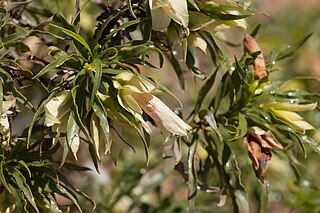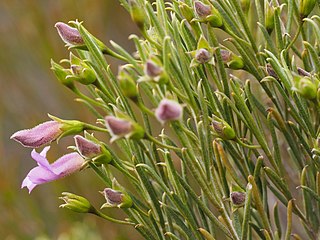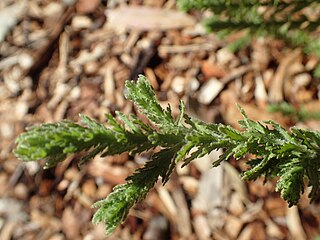
Eremophila subteretifolia, commonly known as Lake King eremophila, is a flowering plant in the figwort family, Scrophulariaceae and is endemic to Western Australia. It is a creeping, prostrate shrub with narrow, sticky, dark green leaves and distinctive orange-red to yellow flowers. It is a rare plant which grows near the edges of salt lakes.

Eremophila alatisepala is a plant in the figwort family, Scrophulariaceae and is endemic to the south-west of Queensland in Australia. It is a very sticky shrub covered with many glandular hairs which produce a resin that often obscures the hairs that produce it. The plant is usually found in stony places on ridges and slopes in the Queensland Channel Country.
Eremophila elderi, commonly known as aromatic emu bush, is a flowering plant in the figwort family, Scrophulariaceae. It is endemic to central Australia where it grows near the border between Western Australia, South Australia and the Northern Territory. It is an erect, aromatic shrub with sticky leaves and branches and usually pale coloured to white flowers. Its specific epithet (elderi) honours an early Australian businessman, Thomas Elder.
Eremophila falcata is a flowering plant in the figwort family, Scrophulariaceae and is endemic to Western Australia. It is a widely distributed shrub with distinctive curved leaves and white, lilac-coloured or pink flowers.

Eremophila flaccida is a flowering plant in the figwort family, Scrophulariaceae and is endemic to Western Australia. It is a low, spreading shrub with sticky, shiny foliage and large, attractive flowers. There are two subspecies, one common and relatively widespread, the other known from only a few locations.

Eremophila galeata is a flowering plant in the figwort family, Scrophulariaceae and is endemic to Western Australia. It is a shrub with sticky, shiny leaves, unusual sepals, a dull pink and brown, spotted petal tube and which grows in stony red soils.

Eremophila gibsonii is a flowering plant in the figwort family, Scrophulariaceae and is endemic to Australia. It is a sticky, glabrous, rounded shrub with narrow leaves and white to lilac-coloured flowers and which occurs in Western Australia, South Australia and the Northern Territory.

Eremophila glutinosa, commonly known as sticky emu bush, is a flowering plant in the figwort family, Scrophulariaceae and is endemic to Western Australia. It is an erect, densely foliaged shrub with branches and leaves sticky and shiny due to the presence of resin. It has hairy sepals and lilac-coloured flowers.

Eremophila labrosa is a flowering plant in the figwort family, Scrophulariaceae and is endemic to Western Australia. It is a shrub with many hairy branches arising from near ground level, narrow, hooked leaves and mauve and blue flowers.
Eremophila pallida is a flowering plant in the figwort family, Scrophulariaceae and is endemic to Western Australia. It is a small, spreading shrub with hairy stems, leaves with a few serrations and reddish purple to violet flowers.
Eremophila perglandulosa is a flowering plant in the figwort family, Scrophulariaceae and is endemic to Western Australia. It is a low, spreading shrub which has small leaves with many glandular hairs and mauve or purple flowers.
Eremophila petrophila is a flowering plant in the figwort family, Scrophulariaceae and is endemic to Western Australia. It is a tall, erect, open shrub with rough branches, narrow, sticky leaves and pale lilac-coloured flowers.

Eremophila pinnatifida, commonly known as Dalwallinu eremophila is a flowering plant in the figwort family, Scrophulariaceae and is endemic to Western Australia. It is a spreading, rounded shrub with aromatic, deeply divided leaves and pale purple flowers which are white with purple spots inside. It is a rare plant, known only from a few areas near Perth.

Eremophila ramiflora is a flowering plant in the figwort family, Scrophulariaceae and is endemic to Western Australia. It is a shrub with sticky branches, broad, sticky leaves and deep red flowers which appear in successive flowerings.

Eremophila rigida is a flowering plant in the figwort family, Scrophulariaceae and is endemic to Western Australia. It is an erect, rigid shrub with thick, hairy, rigid leaves and pale yellowish-cream flowers.
Eremophila setacea is a flowering plant in the figwort family, Scrophulariaceae and is endemic to Western Australia. It is an erect shrub with narrow, glabrous leaves, hairy sepals and light blue to purple petals.
Eremophila simulans is a flowering plant in the figwort family, Scrophulariaceae and is endemic to Western Australia. It is an erect shrub with broad, serrated leaves and violet to purple flowers.
Eremophila succinea is a flowering plant in the figwort family, Scrophulariaceae and is endemic to Western Australia. It is an erect, broom-shaped shrub with sticky, narrow, hooked leaves, narrow, sticky sepals and hairy, pale purple or mauve petals.

Eremophila veneta, commonly known as metallic-flowered eremophila is a flowering plant in the figwort family, Scrophulariaceae and is endemic to Western Australia. It is a low, spreading, sticky shrub with dark green leaves and bluish-green petals.

Eremophila viscida, commonly known as varnish bush, is a flowering plant in the figwort family, Scrophulariaceae and is endemic to Western Australia. It is a large shrub or small tree with large green leaves which are sticky when young, colourful sepals and greenish-white petals with red to purple markings.












